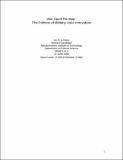| dc.contributor.author | Lindsay, Jon R. | |
| dc.date.accessioned | 2006-07-18T18:00:06Z | |
| dc.date.available | 2006-07-18T18:00:06Z | |
| dc.date.issued | 2006-07-18T18:00:06Z | |
| dc.identifier.uri | http://hdl.handle.net/1721.1/33457 | |
| dc.description.abstract | While military personnel are often involved in the design of information technology, the literature on military innovation generally assumes defense contractors are the primary producers. Furthermore, general organizational theories of user innovation have only been tested on cases involving corporate employees or private citizens in substantially less regulated environments than military users. This paper examines user innovation theory in a military context through a historical study of the user-led development of FalconView, the popular standard for digital mapping applications throughout the U.S. military and some other government organizations. This paper finds that while user innovation theory can explain aspects of the emergence and diffusion of military user innovation, existing theory understates the challenges involved with generating and sustaining user innovation within a complex bureaucracy. Successfully innovating users must be creative with organizational as well as technical resources. | en |
| dc.description.sponsorship | National Science Foundation, IGERT Program | en |
| dc.format.extent | 227089 bytes | |
| dc.format.mimetype | application/pdf | |
| dc.language.iso | | en |
| dc.relation.ispartofseries | PoET Working Papers | en |
| dc.subject | innovation theory | en |
| dc.subject | software application | en |
| dc.subject | military | en |
| dc.subject | user innovation | en |
| dc.title | War Upon the Map: The Politics of Military User Innovation | en |
| dc.type | Working Paper | en |
